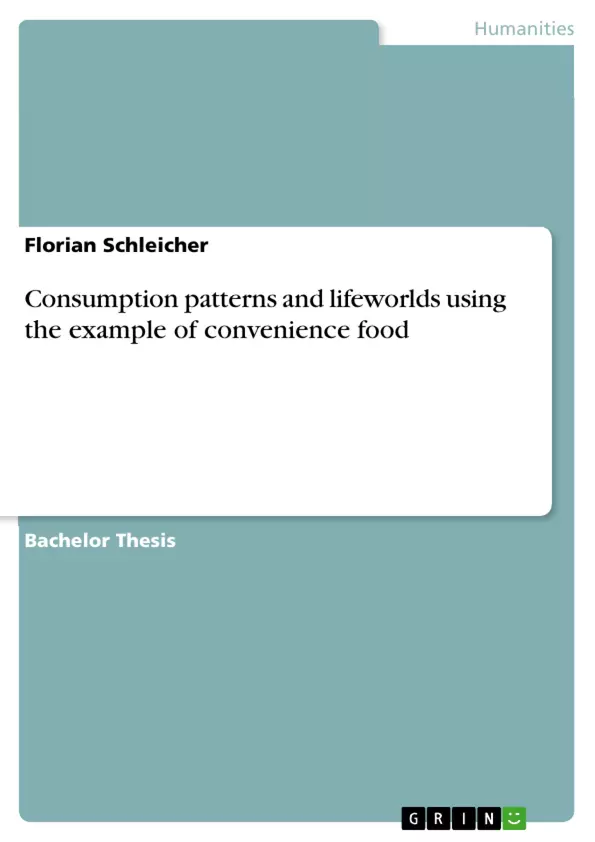In this Bachelor-thesis the consumption of convenience food of German households is
analysed from the perspective of sociology of consumption. At first three theoretical
conceptions are presented and discussed which serve as a basis for the empirical analysis that
is undertaken later.
The first conception is made up by Pierre Bourdieu’s analysis of consumption behaviour of
the French society in the 1960s. His book, Distinction: A Social Critique of Taste, shall be
seen as the methodological starting point for the later empirical research. Following
Bourdieu’s findings, this led to the question whether substantial class differences in the
consumption of convenience food are detectable in German society. George Ritzer’s thesis,
The McDonaldization of Society, and its key terms Efficiency, Calculability, Predictability,
and Control further argue in favour for the choice of convenience food. The third theoretical
pillar is the conception of lifeworld and its development in the field of philosophy and
sociology. The empirical part uses an arrangement of German households in family lifeworlds,
as it is also done by the German Society for Consumer Research. The analysed empirical data
on purchasing behaviour was provided by the market research study Typology of Desires
2010.
After analysis based on standing in society, phase of life, and household composition,
“Students/ Apprentices” and “Unemployed/ Working Poor” resulted as the lifeworlds with the
strongest consumption of convenience food. The initial question in the direction of a social
determination of consumption of convenience food must be negated. Instead can be argued
that consumption is strongly determined by the phase of life, and partially by social status in
society and household composition.
Inhaltsverzeichnis (Table of Contents)
- Introduction
- Part I: Consumption and Sociology.
- Definition of the field of study.
- Emergence of sociology of consumption.
- Part II: Why do we eat what we eat?.
- The Social Construction of Taste.
- Weberian rationalities
- McDonaldization.
- Lifeworld.
- Part III: Empirical Analysis
- Conclusion
Zielsetzung und Themenschwerpunkte (Objectives and Key Themes)
This bachelor thesis analyzes the consumption of convenience food in German households from a sociological perspective. The research aims to understand the factors influencing this consumption, particularly through the lens of social class, life phase, and household composition. The thesis utilizes three main theoretical frameworks: Pierre Bourdieu's social critique of taste, George Ritzer's concept of McDonaldization, and the theory of lifeworlds. Key themes explored in the work include:- The social construction of taste and its influence on food consumption.
- The role of Weberian rationalities and McDonaldization in shaping food choices.
- The impact of lifeworlds on consumption patterns, especially in relation to convenience food.
- The relationship between social class, life phase, and household composition and convenience food consumption.
- The empirical analysis of convenience food consumption in German households using market research data.
Zusammenfassung der Kapitel (Chapter Summaries)
- Introduction: This chapter introduces the topic of convenience food consumption and outlines the research objectives and methodologies employed in the thesis.
- Part I: Consumption and Sociology: This section provides a theoretical background for the study, defining the field of sociology of consumption and exploring its emergence as a distinct area of study.
- Part II: Why do we eat what we eat?: This part delves into the theoretical frameworks underpinning the research. It examines Pierre Bourdieu's social critique of taste and its application to food consumption, the influence of Weberian rationalities and the concept of McDonaldization, and the role of lifeworlds in shaping consumer behavior.
- Part III: Empirical Analysis: This section presents the empirical analysis of convenience food consumption in German households. The data used for the analysis is sourced from a market research study and the findings are analyzed based on factors such as social class, life phase, and household composition.
Schlüsselwörter (Keywords)
This work focuses on the consumption of convenience food in German households, utilizing a sociological perspective. Key themes include social class, life phase, household composition, taste, Weberian rationalities, McDonaldization, lifeworlds, and empirical analysis. The research draws upon the theoretical contributions of Pierre Bourdieu, George Ritzer, and the theory of lifeworlds. The study analyzes market research data to provide insights into the factors influencing convenience food consumption in Germany.- Quote paper
- Florian Schleicher (Author), 2010, Consumption patterns and lifeworlds using the example of convenience food, Munich, GRIN Verlag, https://www.grin.com/document/265955



